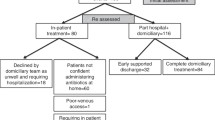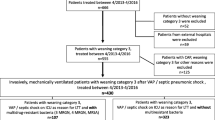Abstract
Study Objectives
The aim of this study was to determine the effects of an antibiotic strategy with intravenous (IV) continuous infusion of a β-lactam (CIBL) antibiotic and high-dose extended-interval (HDEI) tobramycin upon outcomes in patients with cystic fibrosis (CF) requiring invasive mechanical ventilation (IMV) for acute respiratory failure.
Design
The study was a retrospective review from June 1, 2006, to December 1, 2010, of patients at a university hospital with an adult CF center.
Results
The study population included adult CF patients requiring IMV. A total of 15 hospitalizations with IMV episodes were reviewed, involving 10 adult (31.4 ± 11.1 years) CF patients with end-stage lung disease (FEV1 = 23.6 ± 7.8% predicted) and malnutrition (body mass index = 20.5 ± 3.1). Each patient survived to discharge and to follow-up 6 months later without the need for lung transplantation during the study period.
Conclusions
A novel antibiotic strategy with a CIBL antibiotic and HDEI tobramycin improved survival in a small cohort of critically ill CF patients with end-stage lung disease and malnutrition requiring IMV.
Similar content being viewed by others
References
Boat TF, Cheng PW (1989) Epithelial cell dysfunction in cystic fibrosis: implications for airways disease. Acta Paediatr Scand Suppl 363:25–29; discussion 29–30
Matsui H, Randell SH, Peretti SW, Davis CW, Boucher RC (1998) Coordinated clearance of periciliary liquid and mucus from airway surfaces. J Clin Invest 102(6):1125–1131
Puchelle E, Bajolet O, Abély M (2002) Airway mucus in cystic fibrosis. Paediatr Respir Rev 3:115–119
Ulrich M, Worlitzsch D, Viglio S et al (2010) Alveolar inflammation in cystic fibrosis. J Cyst Fibros 9:217–227
Davis PB (1999) Clinical pathophysiology and manifestations of lung disease. In: Yankaskas JR, Knowles MR (eds) Cystic fibrosis in adults, 1st edn. Lippincott-Raven, Philadelphia, pp 45–67
Davis PB, di Sant’Agnese PA (1974) Assisted ventilation for patients with cystic fibrosis. JAMA 239:1851–1854
Lloyd-Still JD, Khaw KT, Shwachman H (1974) Severe respiratory disease in infants with cystic fibrosis. Pediatrics 53:678–682
Garland JS, Chan YM, Kelly KJ, Rice TB (1989) Outcome of infants with cystic fibrosis requiring mechanical ventilation for respiratory failure. Chest 96:136–138
Sood N, Paradowski LJ, Yankaskas JR (2001) Outcomes of intensive care unit care in adults with cystic fibrosis. Am J Respir Crit Care Med 163:335–338
Berlinski A, Fan LL, Kozinetz CA, Oermann CM (2002) Invasive mechanical ventilation for acute respiratory failure in children with cystic fibrosis: outcome analysis and case-control study. Pediatr Pulmonol 34:297–303
Vedam H, Moriarty C, Torzillo PJ, McWilliam D, Bye PT (2004) Improved outcomes of patients with cystic fibrosis admitted to the intensive care unit. J Cyst Fibros 3:8–14
Slieker MG, van Gestel JP, Heijerman HG et al (2006) Outcome of assisted ventilation for acute respiratory failure in cystic fibrosis. Intensive Care Med 32:754–758
Rosenstein BJ, Cutting GR (1998) The diagnosis of cystic fibrosis: a consensus statement. Cystic Fibrosis Foundation Consensus Panel. J Pediatr 132:589–595
Padoan R, Cambisano W, Costantini D et al (1987) Ceftazidime monotherapy vs. combined therapy in Pseudomonas pulmonary infections in cystic fibrosis. Pediatr Infect Dis J 6:648–653
Leeder JS, Spino M, Isles AF, Tesoro AM, Gold R, MacLeod SM (1984) Ceftazidime disposition in acute and stable cystic fibrosis. Clin Pharmacol Ther 36:355–362
Rappaz I, Decosterd LA, Bille J, Pilet M, Bélaz N, Roulet M (2000) Continuous infusion of ceftazidime with a portable pump is as effective as thrice-a-day bolus in cystic fibrosis children. Eur J Pediatr 159:919–925
Roosendaal R, Bakker-Woudenberg IA, Van den Berghe Van-Raffe M, Vink-van den Berg JC, Michel BM (1989) Impact of the dosage schedule on the efficacy of ceftazidime, gentamicin and ciprofloxacin in Klebsiella pneumoniae pneumonia and septicemia in leukopenic rats. Eur J Clin Microbiol Infect Dis 8:878–887
Craig WA, Ebert SC (1992) Continuous infusion of beta-lactam antibiotics. Antimicrob Agents Chemother 36:2577–2583
Daenen S, Erjavec Z, Uges DR, De Vries-Hospers HG, De Jonge P, Halie MR (1995) Continuous infusion of ceftazidime in febrile neutropenic patients with acute myeloid leukemia. Eur J Clin Microbiol Infect Dis 14:188–192
Nicolau DP, Nightingale CH, Banevicius MA, Fu Q, Quintiliani R (1996) Serum bactericidal activity of ceftazidime: continuous infusion versus intermittent injections. Antimicrob Agents Chemother 40:61–64
Vogelman B, Craig WA (1986) Kinetics of antimicrobial activity. J Pediatr 108(5 Pt 2):835–840
Vondracek TG (1995) Beta-lactam antibiotics: is continuous infusion the preferred method of administration? Ann Pharmacother 29:415–424
Rafati MR, Rouini MR, Mojtahedzadeh M et al (2006) Clinical efficacy of continuous infusion of piperacillin compared with intermittent dosing in septic critically ill patients. Int J Antimicrob Agents 28:122–127
Lau WK, Mercer D, Itani KM et al (2006) Randomized, open-label, comparative study of piperacillin-tazobactam administered by continuous infusion versus intermittent infusion for treatment of hospitalized patients with complicated intra-abdominal infection. Antimicrob Agents Chemother 50:3556–3561
Roberts JA, Paratz J, Paratz E, Krueger WA, Lipman J (2007) Continuous infusion of beta-lactam antibiotics in severe infections: a review of its role. Int J Antimicrob Agents 30:11–18
Roberts JA, Webb S, Paterson D, Ho KM, Lipman J (2009) A systematic review on clinical benefits of continuous administration of beta-lactam antibiotics. Crit Care Med 37:2071–2078
Riethmueller J, Junge S, Schroeter TW et al (2009) Continuous vs thrice-daily ceftazidime for elective intravenous antipseudomonal therapy in cystic fibrosis. Infection 37:418–423
Hubert D, Le Roux E, Lavrut T et al (2009) Continuous versus intermittent infusions of ceftazidime for treating exacerbation of cystic fibrosis. Antimicrob Agents Chemother 53:3650–3656
Paradisi F, Corti G (1995) Once-daily dosing regimen for aminoglycoside plus betalactam combination therapy of serious lower respiratory tract infections. J Chemother 7:338–343
Powell SH, Thompson WL, Luthe MA et al (1983) Once-daily vs. continuous aminoglycoside dosing: efficacy and toxicity in animal and clinical studies of gentamicin, netilmicin, and tobramycin. J Infect Dis 147:918–932
Bates RD, Nahata MC, Jones JW et al (1997) Pharmacokinetics and safety of tobramycin after once-daily administration in patients with cystic fibrosis. Chest 112:1208–1213
Bragonier R, Brown NM (1998) The pharmacokinetics and toxicity of once-daily tobramycin therapy in children with cystic fibrosis. J Antimicrob Chemother 42:103–106
Vic P, Ategbo S, Turck D et al (1998) Efficacy, tolerance, and pharmacokinetics of once daily tobramycin for pseudomonas exacerbations in cystic fibrosis. Arch Dis Child 78:536–539
Aminimanizani A, Beringer PM, Kang J, Tsang L, Jelliffe RW, Shapiro BJ (2002) Distribution and elimination of tobramycin administered in single or multiple daily doses in adult patients with cystic fibrosis. J Antimicrob Chemother 50:553–559
Smyth A, Tan KH, Hyman-Taylor P et al (2005) Once versus three-times daily regimens of tobramycin treatment for pulmonary exacerbations of cystic fibrosis–the TOPIC study: a randomised controlled trial. Lancet 365:573–578
Riethmueller J, Ballmann M, Schroeter TW et al (2009) Tobramycin once- vs thrice-daily for elective intravenous antipseudomonal therapy in pediatric cystic fibrosis patients. Infection 37:424–431
Burkhardt O, Lehmann C, Madabushi R, Kumar V, Derendorf H, Welte T (2006) Once-daily tobramycin in cystic fibrosis: better for clinical outcome than thrice-daily tobramycin but more resistance development? J Antimicrob Chemother 58:822–829
Soulsby N, Bell S, Greville H, Doecke C (2009) Intravenous aminoglycoside usage and monitoring of patients with cystic fibrosis in Australia. What’s new? Intern Med J 39:527–531
Prescott WA Jr, Nagel JL (2010) Extended-interval once-daily dosing of aminoglycosides in adult and pediatric patients with cystic fibrosis. Pharmacotherapy 30:95–108
Contopoulos-Ioannidis DG, Giotis ND, Baliatsa DV, Ioannidis JP (2004) Extended-interval aminoglycoside administration for children: a meta-analysis. Pediatrics 114:e111–e118
Smyth AR, Bhatt J (2010) Once-daily versus multiple-daily dosing with intravenous aminoglycosides for cystic fibrosis. Cochrane Database Syst Rev (1):CD002009
Flume PA, Mogayzel PJ Jr, Robinson KA et al (2009) Cystic fibrosis pulmonary guidelines: treatment of pulmonary exacerbations. Am J Respir Crit Care Med 180:802–808
Acknowledgment
The authors greatly appreciated the outstanding assistance of Linda Combs in the preparation and development of the manuscript.
Disclosure
There are no conflicts of interest to declare.
Author information
Authors and Affiliations
Corresponding author
Rights and permissions
About this article
Cite this article
Hayes, D., Mansour, H.M. Improved Outcomes of Patients with End-stage Cystic Fibrosis Requiring Invasive Mechanical Ventilation for Acute Respiratory Failure. Lung 189, 409–415 (2011). https://doi.org/10.1007/s00408-011-9311-6
Received:
Accepted:
Published:
Issue Date:
DOI: https://doi.org/10.1007/s00408-011-9311-6




